A Short History of the SPCRR
Set your calendars to the late 1800's and your location to the San Francisco Bay area. A 3 foot narrow gauge railroad, the South Pacific Coast, has dared to lay track from Alameda and Oakland south to Santa Cruz right under the mighty Central Pacific's nose! The SPCRR was able to perform this feat largely because the economic strangle-hold the CPRR was exerting on the area (bleeding the local shippers nearly to death) made the big four (Stanford, Hopkins, Huntington, and Crocker) extremely unpopular and also because the CPRR was less than thorough with its corruption of public officials. The SPCRR was able to exploit these chinks in the CP's armor to obtain trackage rights through Oakland and Alameda streets.
The SPC started construction at Dumbarton point in 1876 (after buying what was left of the Santa Clara Valley RR, a failed venture from two years earlier) and ran track to the future site of Newark. Newark didn't exist at the time but in typical RR fashion the SPC laid out a town surrounding the depot and proceeded to sell lots to folks who wanted to escape from the hustle and bustle of San Francisco. (RR's it appears were the original cause of suburban sprawl!). Tracks went south from Newark to Santa Clara (following the surveyed path of the Santa Clara Valley RR) and San Jose. The Newark, the largest paddle-wheel ferry on San Francisco Bay, carried passengers between San Francisco and the Dumbarton landing. But although the SPC trains provided fast service from Santa Clara to Dumbarton the ferry trip to San Francisco from Dumbarton point took too long. So in 1877 trackwork started north toward Alameda (and later Oakland). At Alameda the tracks terminated at a "mole" where ferries (including the Newark) docked and quickly whisked passengers and SPC freight cars across the bay to SF where the RR cars were handed off to the precursor of the SF Belt Railway.
The SPC management had early on fixed its eyes on the vast forests of giant coastal redwood trees in the Santa Cruz mountains and began construction of a right of way south toward Santa Cruz to provide an efficient way to get the trees to market. In contrast to the usual practices of narrow gauge RR's however curve radii were kept relatively wide and the grades well below 2%. This however did require many tunnels some of which were quite long (the summit tunnel between Wrights and Laurel was over 6000' and the tunnel between Laurel and Glenwood was over 5000'), very expensive, and difficult to build in the unstable rock of the Santa Cruz mountains. Pockets of gas caused several explosions during tunnel construction claiming dozens of lives.
In the early 1870's another railroad had been chartered to build track between Santa Cruz and Felton (one of the earliest railroads in California). The SPC purchased the Santa Cruz & Felton lock, stock, and barrel using its right-of-way for the last leg of the trip south from Felton to Santa Cruz following the course of the San Lorenzo river. The SC&F in contrast to the SPC trackwork had steep grades (up to 4%) and very tight turns one of which was so sharp the SPCRR was forced to drill a tunnel to bypass it.
Never-the-less, in 1880 it became possible to board a ferry in SF, get on a train in Alameda and reach Santa Cruz in 3 1/2 hours. Such incredible break-neck speed! Prior to the railroad the trip would have taken 2 days by stagecoach.
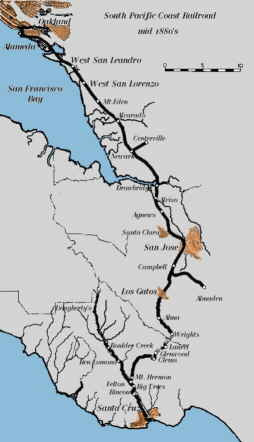 |
The trip south was awesome, first down the east edge of San Francisco bay past areas that would become San Lorenzo, San Leandro, Hayward, Union City, Newark, Fremont, the notorious draw-bridge area (populated entirely by gambling establishments and houses of ill-repute), Alviso, and Agnews entering the farm and orchard country around Santa Clara.
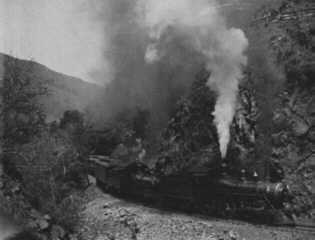 |
|
Double-headed passenger train heading upgrade alongside
Los Gatos Creek - courtesy William Wulf collection
|
The track continued south close to the route of present day highway 17 (880) through San Jose, Campbell and Los Gatos. From Los Gatos it headed up into the mountains through Wildcat Canyon following the course of Los Gatos Creek. In places the hills next to the creek were so steep that workmen had to be lowered into the creek bed in baskets to carve out the roadbed. The tracks were forced to cross and re-cross the creek 11 times before reaching the summit. The mountains in this area were dotted with small farms and orchards.
The local farmers found the SPC a convenient way to ship produce to the city markets and receive whatever supplies they might need. With rail access available resort hotels sprang up in places such as Alma and Eva, quickly becoming popular with the big city crowds from San Francisco, eager to escape to the more pastoral country scenery.
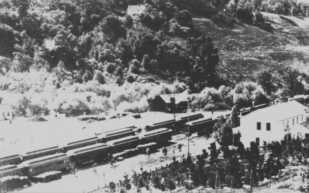 |
|
A special excursion train with children from San Francisco
has arrived at Alma for a holiday - courtesy Finescale Railroader and
Bill Wulf collection
|
The arrival of the railroad also saw small lumber operations grow in places where it previously would have been impractical to get logs to a saw mill.
At the north end of the summit tunnel the mountain hamlet of Wrights grew, a beneficiary of the tunnel construction work and later on the patronage of the maintenance crews when the SPC built a bunk house there. Wrights also was a shipping point for the farmers in the area.
Laurel, the highest point of the line at an elevation of 910 feet, was shoe-horned between the summit and Glenwood tunnels (eachover a mile in length) at the head of Soquel Canyon. Originally called Highlands, it was so isolated 10 years passed before a town grew. The depot itself wasn't constructed until 1889. In the mid 1890's a sawmill was erected there by Fred Hihn taking advantage of the giant redwoods growing in the upper Soquel valley. This sawmill had its own spur but it was far too steep for locomotive so flat cars were lowered and raised by a steam powered winch.
Glenwood, reached through a tunnel southwest of Laurel was near a resort owned by Charley Martin. The Glenwood Magnetic Springs saw quick growth when the SF crowd began to arrive by train and soon other resorts appeared. Glenwood was the site of a SPC division yard and had the only turning facility (an Armstrong turntable) between Los Gatos and Felton.
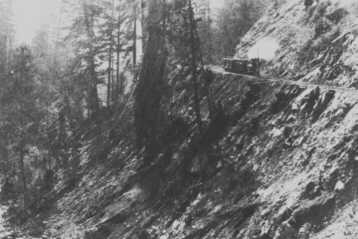 |
|
Switzerland in America, SPC 12 poses along the San
Lorenzo River canyon in 1881 - Courtesy Finescale Railroader and Bill
Wulf collection
|
Yet another tunnel and the tracks entered Zayante canyon and dipped down toward the San Lorenzo river at Felton. The trackwork here clung for dear life to the sides of the extremely steep mountain side. The area was dubbed "Switzerland in America" by the railroad's PR department. Felton was originally a logging community although by the early 1880's the supply of trees had dwindled and logging was moving farther up the San Lorenzo. The SPC ran a branch line to tap the lumber industry and the town of Boulder Creek at its northern terminus thrived sending millions of board-feet of lumber over the mountains on the SPC each year. At Santa Cruz SPC tracks ran through town finally reaching Monterey bay, the beach and Gharkeys wharf. For a while until the tracks were standard gauged the SPC narrow gauge cars could continue as far south as Watsonville via the Santa Cruz RR (which became a subsidiary of the Southern Pacific in 1881)..
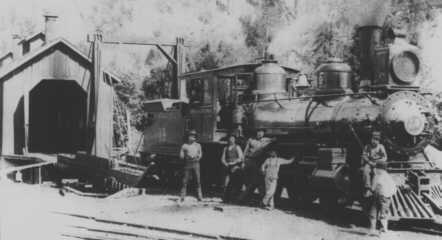 |
|
Engine 19 a 4-4-0 and the Boulder Creek engine house
and turntable - Courtesy Finescale Railroader and Bill Wulf collection
|
James Fair and Alfred "Hog" Davis accomplished this feat using funds gleaned in the Comstock mining area. In 1887 after having given the Central Pacific (and later the Southern Pacific) a competivie battle it would not soon forget (there is speculation that James Fair was snubbed by two of the Central Pacific's big four and built the South Pacific Coast RR as revenge!) and needing money for other ventures the South Pacific Coast RR was leased to its arch-rival, the Southern Pacific.
The SP immediately started the process of standard gauging the line. This process reached south to Los Gatos by late 1894 (as dual gauge track) but the completion of the standard gauging wasn't accomplished until 1908 having been delayed two years by the 1906 San Francisco earthquake (which collapsed the summit tunnel).
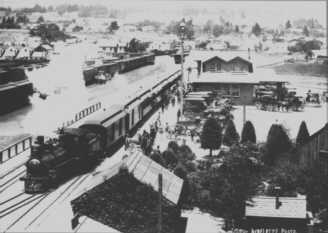 |
|
Santa Cruz express arriving at Santa Cruz behind #20.
The period is the mid 1890's - Courtesy Finescale Railroader and Bill
Wulf collection
|
"Hog" Davis remained a frequent rider on the line but James Fair regretted the lease almost immediately and fought to keep the line a narrow gauge. A fight he lost.
The line saw gradually decreasing lumber revenues during the late 1910's although the passenger route to Santa Cruz stayed popular for 2 more decades. The end of the line came in 1940 when a spectacular storm washed out several miles of track in the Zayante canyon area (always a maintenance headache). The line was abandoned and SP service to Santa Cruz now passed solely through Watsonville. In the 1950's the Lexington reservoir flooded Alma and Lexington and several miles of the SPC roadbed that clung to the edges of Los Gatos Creek. The SPC tracks north of Los Gatos are still present and in use by the SP today.